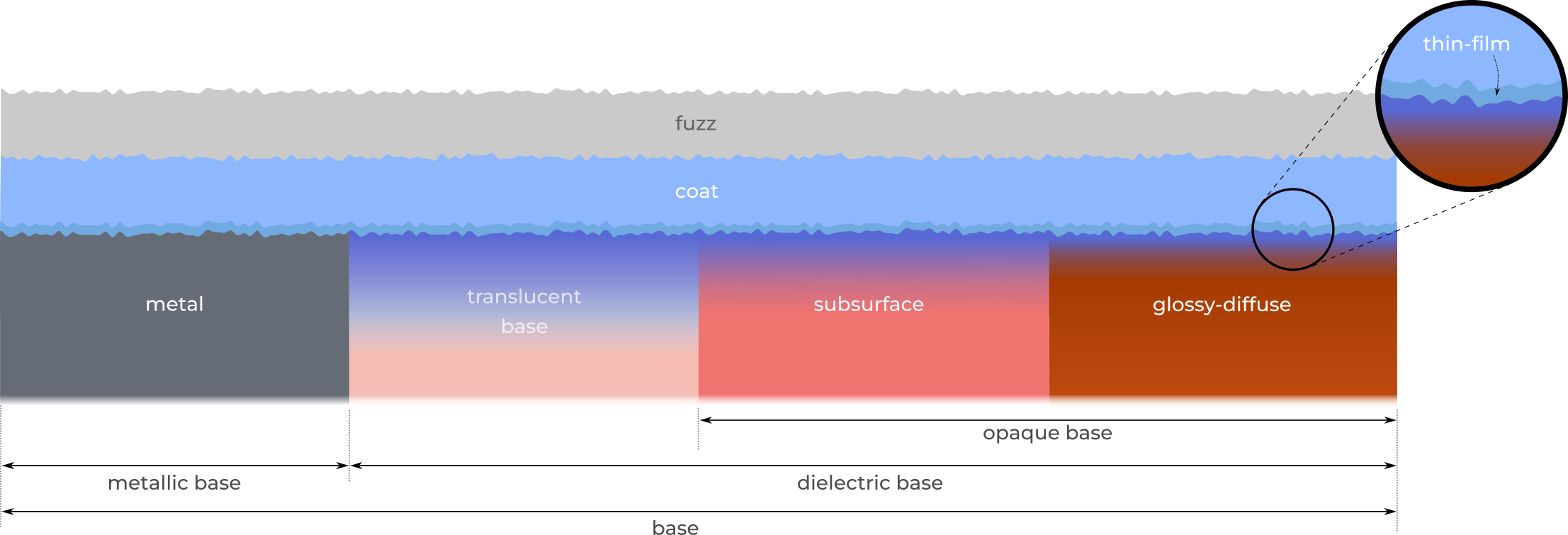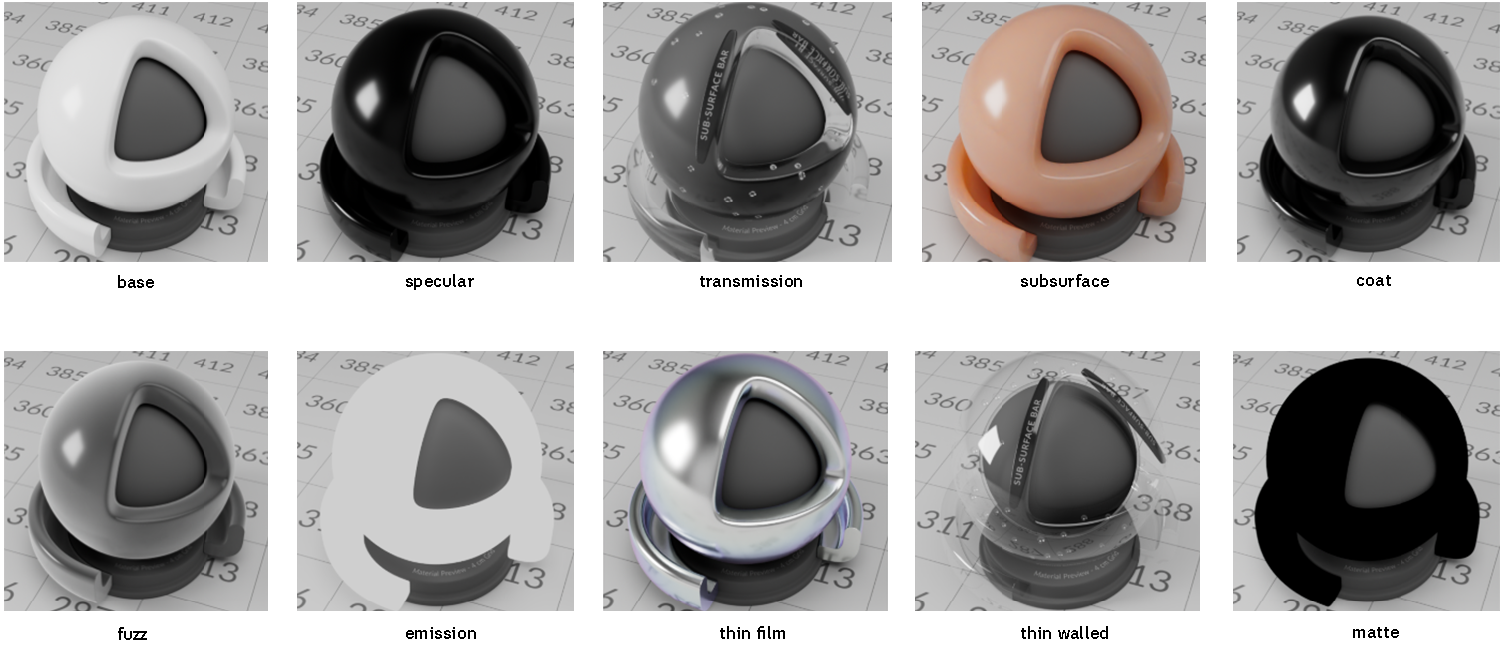Introduction
OpenPBR Surface is a digital material model designed as a collaboration between the teams at Adobe and Autodesk, under the guidance of the MaterialX Technical Steering Committee. OpenPBR Surface is a step towards more convergence in the industry and more efficient workflows for 3D content creators. It is a physically based surface model based on Autodesk Standard Surface and Adobe Standard Material and is therefore an evolution of two production-proven models.
OpenPBR Surface is a highly art-directable material model: an expressive yet intuitive set of parameters, neatly grouped, with direct control over the perceived colors, detailed enough to represent most real-world materials. It is physically based, meaning that materials look realistic by default, while still giving artists the freedom to represent imaginary ones. OpenPBR Surface aims to strike a balance between simplicity of use and expressivity. This physically based shading model has been developed to offer creatives a more artist-friendly bridge between different software applications. It is a subproject of MaterialX within the Academy Software Foundation.
How to use
OpenPBR Surface is the default node in Maya, and an openPBRSurface1 node is created with every new scene. To create, click OpenPBR in the Create tab of the Hypershade or click its icon in the Rendering shelf. Assign these shaders to your objects as you would any other shader.
Presets such as car paint, frosted glass, and plastic are available. Click Presets on the OpenPBR Property Editor or Attribute Editor to select and apply a preset.
Composition
OpenPBR Surface is a physically-based shader (like Standard Surface) capable of producing many types of materials. It is intended to be a common interface between products, as well as something practical that works well and looks plausible for most day-to-day use cases.
OpenPBR Surface adopts a specific form of material structure that has proved useful as a general purpose model in media and entertainment. In outline the structure consists of:
- A
base substrate
made of a mixture of metal. The interface (dielectric or
metal) of this base layer produces the primary specular reflection lobe. The dielectric base represents either of three components, that can be statistically mixed:
- Glossy-diffuse: dielectric with opaque internal media, such as wood, concrete, cardboard, and wall-paint.
- Subsurface: dielectric with highly scattering internal media, such as plastic, marble, skin, vegetation, and food.
- Translucent-base: dielectric with translucent internal media, such as glass, crystals, and liquids.
- Coat: An optional layer of dielectric, which may have an absorbing medium, acting as a coating on top of the base substrate. The dielectric interface of this coat layer provides a secondary specular lobe.
- Fuzz: An optional layer representing the reflection from micro-fibers (such as fine hair, peach fuzz, textile strands, and dust grains) on top of everything else.
It also supports emission, an iridescent thin-film, and a thin-walled mode for modeling two dimensional, semi-transparent sheets such as window panes, paper and leaves.

Schematic illustration of the idealized physical material that the OpenPBR Surface shader models.
Material Types
By default, the parameters are appropriate for materials such as plastic, wood or stone. By setting a few key weight parameters to 1, different types of materials can be quickly created:
- Metalness: gold, silver, iron, car paint.
- Transmission: glass, water, honey, soap bubble.
- Subsurface: skin, marble, wax, paper, leaves.
- Thin Walled: paper, leaves, soap bubble.
Parameter values between 0 and 1 may be used to create more complex materials that are a mix of the basic material types.
OpenPBR Surface parameter groups:

Energy Conservation
The OpenPBR Surface shader is a physically-based shader and is thus energy conserving by default. All its layers are balanced so that the amount of light leaving the surface does not exceed the amount of incoming light.
For example, as a surface is made more specular, the diffuse layer contribution is reduced accordingly to ensure energy conservation.

Stone rendered as glossy-diffuse surface, composed of diffuse lobe (left), specular lobe (middle), and their normalized sum. Near the specular highlight the diffuse lobe is automatically reduced since energy is conserved.

White furnace test displaying energy preservation.
Rendering support
You can preview OpenPBR Surface shading in the Material Viewer of the Hypershade using the Hardware or Arnold renderers or any other software renderer that supports OpenPBR. It works with both direct and indirect lighting (image based lighting) in the viewport and in the Hypershade Material Viewer.
The following OpenPBR material surface presets are available in the various Arnold plug-ins.
- Balloon
- Blood
- Brushed metal
- Bubble
- Car paint
- Metallic car paint
- Ceramic
- Chrome
- Clay
- Clear water
- Copper
- Deep water
- Diamond
- Foam
- Frosted glass
- Glass
